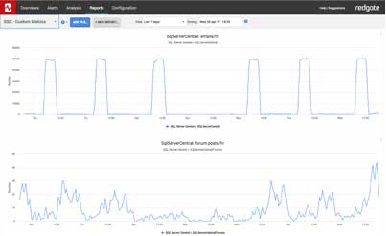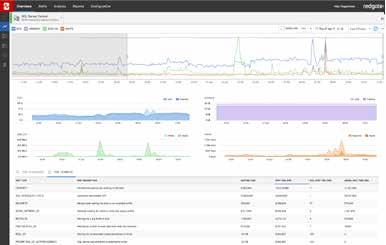Metrics install automatically if you have Redgate Monitor installed.
If you are using Redgate’s SQL Server monitoring tool, Redgate Monitor, you can instantly install and run this metric on your servers.
Reports the number of changes to logins, users, roles in the past 10 minutes. It measures every change but doesn’t tell you if this is a drift from what it should be, since it might only be a permission being temporarily created and then revoked.
First, create the following function in the database on the monitored SQL Server instance. It uses the default trace:
|
1 2 3 4 5 6 7 8 9 10 11 12 13 14 15 16 17 18 19 20 21 22 23 24 25 26 27 28 29 30 31 32 33 34 35 36 37 38 39 40 41 42 43 44 45 46 47 48 49 50 51 52 53 54 55 56 57 58 59 60 61 62 63 |
IF Object_Id('dbo.SeeAccessControlChanges') IS NOT NULL DROP function dbo.SeeAccessControlChanges GO CREATE FUNCTION dbo.SeeAccessControlChanges /** Summary: > This function gives you a list of security events concerning users, roles and logins from the default trace Author: Phil Factor Date: 04/10/2018 Examples: - Select * from dbo.SeeAccessControlChanges(DateAdd(day,-1,SysDateTime()),SysDateTime()) columns: datetime_local, action, data, hostname, ApplicationName, LoginName, traceName, spid, EventClass, objectName, rolename, TargetLoginName, category_id, ObjectType Returns: > datetime_local datetime2(7) action nvarchar(816) data ntext hostname nvarchar(256) ApplicationName nvarchar(256) LoginName nvarchar(256) traceName nvarchar(128) spid int EventClass int objectName nvarchar(256) rolename nvarchar(256) TargetLoginName nvarchar(256) category_id smallint ObjectType nvarchar(128) **/ ( @Start DATETIME2,--the start of the period @finish DATETIME2--the end of the period ) RETURNS TABLE --WITH ENCRYPTION|SCHEMABINDING, .. AS RETURN ( SELECT Convert(--correct the date for local time. DATETIME2, SwitchOffset(StartTime, DateName(TzOffset, SysDateTimeOffset())) ) AS datetime_local, 'User '+Coalesce( LoginName+ ' ','unknown ')+ CASE EventSubclass --interpret the subclass for these traces WHEN 1 THEN 'added ' WHEN 2 THEN 'dropped ' WHEN 3 THEN 'granted database access for ' WHEN 4 THEN 'revoked database access from ' ELSE 'did something to ' END+ Coalesce(TargetLoginName,'') + Coalesce( CASE EventSubclass WHEN 1 THEN ' to object ' ELSE ' from object ' end+objectname, '') AS action, Coalesce(TextData,'') AS [data], hostname, ApplicationName, LoginName, TE.name AS traceName, spid, EventClass, objectName, rolename, TargetLoginName, TE.category_id, SysTSV.subclass_name AS ObjectType FROM::fn_trace_gettable(--just use the latest trace (SELECT TOP 1 traces.path FROM sys.traces WHERE traces.is_default = 1), DEFAULT) AS DT LEFT OUTER JOIN sys.trace_events AS TE ON DT.EventClass = TE.trace_event_id LEFT OUTER JOIN sys.trace_subclass_values AS SysTSV ON DT.EventClass = SysTSV.trace_event_id AND DT.ObjectType = SysTSV.subclass_value WHERE StartTime BETWEEN @start AND @finish AND TargetLoginName IS NOT NULL ) GO |
Metric definition
Name
AccessControlChanges
Description
Reports the number of changes to logins, users, roles in the past 10 minutes. It measures every change but doesn't tell you if this is a drift from what it should be, since it might only be a permission being temporarily created and then revoked.
The T-SQL query that will collect data
Instances to collect from
default
Databases to collect from
master
Collection frequency
5 mins
Use collected or calculated values
Leave the Use a calculated rate of change between collections check box unchecked
Metric collection
Enabled
Alert definition
Alert name
Change to a login, role or user
Description
Raise an alert when the metric value goes
Above the defined threshholds
Default threshold values
| High: | |
| Medium: | |
| Low: | 1 |
Raise an alert when the threshold is passed for
collections
Alert is
Enabled
 9,080
9,080 
